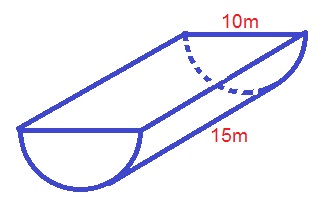All High School Math Resources
Example Questions
Example Question #11 : Cones
What is the volume of a cone with base radius 4, and height 6?
The volume of a cone is 


The volume of this cone is thus:
= 
Example Question #111 : Geometry
What is the surface area of a cone with a radius of 4 and a height of 3?
Here we simply need to remember the formula for the surface area of a cone and plug in our values for the radius and height.
Example Question #1 : How To Find The Surface Area Of A Cone
The lateral area is twice as big as the base area of a cone. If the height of the cone is 9, what is the entire surface area (base area plus lateral area)?
9π
54π
81π
27π
90π
81π
Lateral Area = LA = π(r)(l) where r = radius of the base and l = slant height
LA = 2B
π(r)(l) = 2π(r2)
rl = 2r2
l = 2r

From the diagram, we can see that r2 + h2 = l2. Since h = 9 and l = 2r, some substitution yields
r2 + 92 = (2r)2
r2 + 81 = 4r2
81 = 3r2
27 = r2
B = π(r2) = 27π
LA = 2B = 2(27π) = 54π
SA = B + LA = 81π
Example Question #11 : Solid Geometry
What is the surface area of a cone with a height of 8 and a base with a radius of 5?
To find the surface area of a cone we must plug in the appropriate numbers into the equation
where 

First we must find the area of the circle.
To find the area of the circle we plug in our radius into the equation of a circle which is
This yields 
We then need to know the surface area of the cone shape.
To find this we must use our height and our radius to make a right triangle in order to find the lateral height using Pythagorean’s Theorem.
Pythagorean’s Theorem states
Take the radius and height and plug them into the equation as a and b to yield
First square the numbers
After squaring the numbers add them together
Once you have the sum, square root both sides
After calculating we find our length is
Then plug the length into the second portion of our surface area equation above to get
Then add the area of the circle with the conical area to find the surface area of the entire figure
The answer is 
Example Question #11 : How To Find The Surface Area Of A Cone
What is the surface area of a cone with a radius of 6 in and a height of 8 in?
96π in2
36π in2
66π in2
112π in2
60π in2
96π in2
Find the slant height of the cone using the Pythagorean theorem: r2 + h2 = s2 resulting in 62 + 82 = s2 leading to s2 = 100 or s = 10 in
SA = πrs + πr2 = π(6)(10) + π(6)2 = 60π + 36π = 96π in2
60π in2 is the area of the cone without the base.
36π in2 is the area of the base only.
Example Question #1 : How To Find The Surface Area Of A Cone
Find the surface area of a cone that has a radius of 12 and a slant height of 15.
The standard equation to find the surface area of a cone is
where 

Plug in the given values for 

Example Question #5 : How To Find The Surface Area Of A Cone
Find the surface area of the following cone.

The formula for the surface area of a cone is:
where 

Plugging in our values, we get:
Example Question #2 : How To Find The Surface Area Of A Cone
Find the surface area of the following cone.

The formula for the surface area of a cone is:
Use the Pythagorean Theorem to find the length of the radius:
Plugging in our values, we get:
Example Question #3 : How To Find The Surface Area Of A Cone
Find the surface area of the following half cone.

The formula for the surface area of the half cone is:
Where 


Use the Pythagorean Theorem to find the height of the cone:
Plugging in our values, we get:
Example Question #1 : Other Polyhedrons
Find the surface area of the following half-cylinder.

The formula for the surface area of a half-cylinder must include one-half of the surface area of a cylinder, which would be:
We also need to add the area of the new rectangular face that is created by cutting the cylinder in half. The area of this rectangle would be:
where the length of the rectangle is the same as the height of the half-cylinder, and the width of the rectangle is the same as the diameter of the base of the half-cylinder. So we can rewrite the area of the rectangle as:
Now we can combine the two area formulas to find the total surface area of the half-cylinder:
where 


Plugging in our values, we get:
Certified Tutor
Certified Tutor
All High School Math Resources


















































































